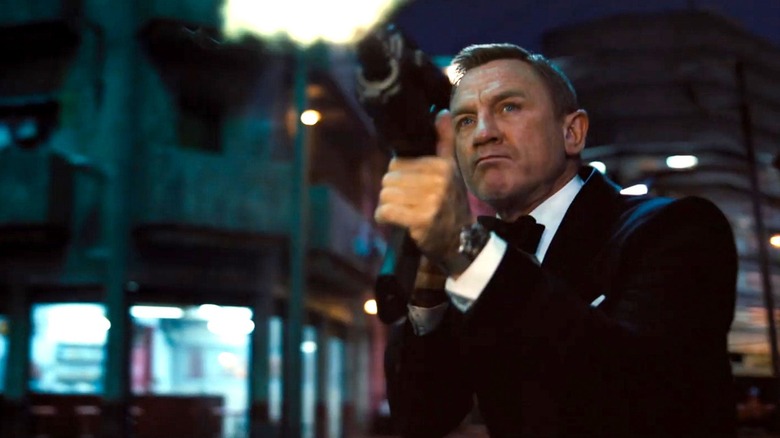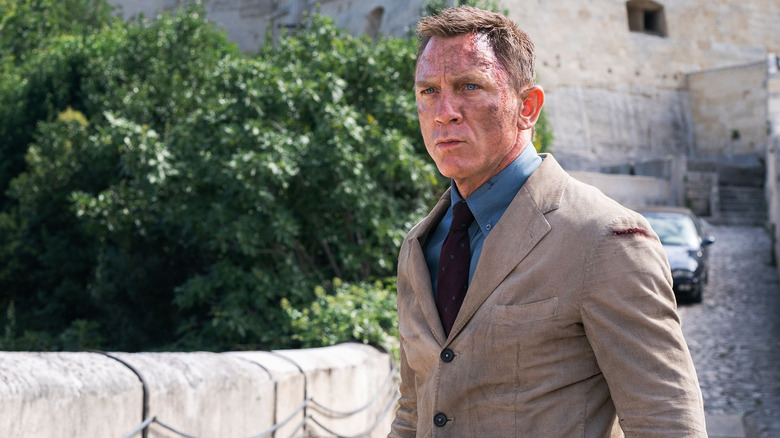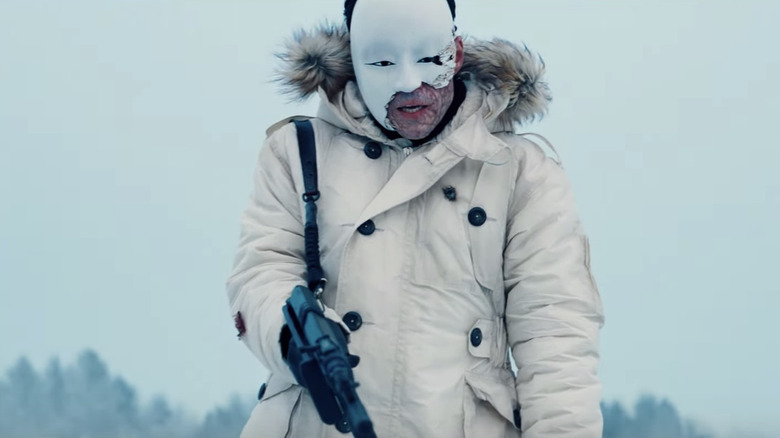
Cinematographer Linus Sandgren was hired to shoot the new James Bond movie "No Time to Die" after the right people saw his work on the astronaut drama "First Man." Director Cary Joji Fukunaga and producer Barbara Broccoli attended a private screening and were sold on Sandgren, whose other credits include "La La Land" and "American Hustle." Working alongside Fukunaga, the director of photography shot Daniel Craig's final chapter on 35mm, 65mm, and IMAX cameras. The results are lavish.
With this globetrotting spy film, the Academy Award-winning cinematographer was always looking for emotion, even in the largest of action scenes. Since this is Daniel Craig's farewell, there was plenty there for him to work with. During a recent interview with /Film, Sandgren went into great detail about what it was like to make "No Time to Die."
"That Was Very Important ... That The Story Was Grounded That Way."

"No Time to Die" is very much in keeping with the tone and style of the recent films, but it also has more of the glamour and bombast of the older Bond films. Aesthetically, did you and Cary want to harken back to the classic Bond films?
Totally. That was the big deal of it. In our initial call, for me to work with Cary on this, he talked a lot about that. It's a combination of finding the heart of Bond as a character over the years, like the actual core Bond. What is Bond for us? And we very much agreed on that too, where Daniel Craig has brought a deeper character to Bond. I think it's more emotional and more raw and layered, but still has all of that previous characteristics, like he's got the humor.
But visually, we definitely sort of wanted to refer to the heart of Bond. What is the heart of Bond? And to us both, an adventure. It should be an escapade. It should be romantic action, but still brutal and larger than life, but also real. For Cary, it was very important to keep that realistic action. Anything that happens to him can happen. And also to the largest extent, it actually happens while we're filming it. We're filming it in such a way that it's actually real stunts, and people are flying motorcycles up the walls.
So that was very important for Cary, that the story was grounded that way. If it's completely fantastical stunts, it's hard to also make it a heightened reality on top of that. The core of the whole story is so personal to Bond, right? Every decision he makes is personal, more than an obligation for being in the service or something.
It's more about his personal choices here in this particular film, so that all helped to design the worlds for him sort of as if they could exist realistically, but they just happened to take place in the sunset, in this romantic scene. It's like, oh, it happens to be very pretty light in Matera, Italy, when he has this getaway with his loving lady. And then once that turns into a brutal action scene, suddenly that location is bright and actually very conveniently hard and rocky and not so nice to try to run away from.
So we always visually try to connect with the story and see what the story really emotionally, how we emotionally could visualize it. I think that's important always, anyway. It's much easier, I think, and better to think about cinematography as an emotional tool. It needs to be looking at what the scene is about and what it emotionally describes and what it wants to describe. And then you describe it emotionally instead of literally what is going on.
It would be so much better emotionally if this takes place in twilight. It would feel much more moody. So that's one aspect of it, where we sort of designed the scenes that way, that they follow the emotion of the story and with the colors and with the lighting and with the way we move the camera.
And sometimes if it was a raw action sequence where Bond is really in a tough spot or situation, you want to feel with him how hard this must be, like we did that oner in handheld. And if it wasn't handled or if it wasn't a oner, it may not have been as intense. I think it helped the intensity of that scene.
In the same way, like when we did "La La Land," a oner would rather represent as well, that whatever you see is actually happening. That was sort of our intention with the oner for that. It's not a cut. It's not interrupted, not technically that way. But when you see it, you feel like you're watching what's going on for real.
And in this case, we did these things in order to just get the audience more immersed and get the feeling that Bond may not be in complete control in those moments. While when people are in control, we were moving much more smooth. That's why that twisting shot, that's also in the trailer, but when they break in through that window, it's like, we twist around, we track very straight. We track and pan very deliberately with precision, because it's a precision operation. That was the goal of explaining that scene as this is a precision.
It's also suspenseful. That's why we put it at night. If that was a daytime scene, it may not have been as emotionally suspenseful. We wanted it to be heightened realism, so more larger than life. And therefore the color palette there fitted better, we thought, to be like twilight or dusk outside, or breaking in. They're still working in there for some reason. And then the contrast in color palettes inside in order to sort of juice it up and make it more juicy. All of that is in lighting, really, and then shot on film to capture colors deeper.
And then certain scenes, we went IMAX, to open up for the audience. If you watch it in an IMAX theater, you are even more immersed and engulfed in the visual.
"Oh, It Actually Works."

Directors used to complain about IMAX cameras, just how big and noisy and inconvenient they are. How's your experience been?
So, on "First Man," I used IMAX cameras on the moon. We also shot on super 16. You're super 16 inside the cockpits, inside the moon lander. And then as you get out into that really surreal world, we shot IMAX in order to get a really crisp, really rich image. You see every thing in the details of the set, and you see all colors that are there.
It's quite ironic and interesting, I thought, and Damien too, in that case, that we go from something so emotionally intimate with 16 and go to that really large sharp format, and you see everything, but there's nothing there. So the moon is the planet of the dead, in that case, so that was a sort of a creative choice.
And in this film, it was about opening up the image for the audience to be more engulfed in the ride and capture all these colors in film. So you always decide upon things for that reason, I think I do at least. I wouldn't worry about any format. I would just like, think of first, what is the best for the scene? And then we worry, and then you test it. And we were like, "Okay, let's see the blimp." And on the camera test, we had a blimp, and we put it on a dolly. First, the camera weighs 80, 90 pounds. And then it's a big box, plastic box on top of it, to shoot sound.
That was bulky, but you can shoot with it that way. So it's all up to you, how much you want to compromise when it comes to those things. But luckily, most of our sequences were not super dependent on sound. I mean, they were dependent on sound, but you can record sound with them if you're not doing intimate dialogue scenes. So we decided for the intimate dialogue scenes in those sequences to shoot 65. Other parts was that we just shot IMAX anyway, and they ADR-ed it, or we just didn't need sound, that on set sound. They can, to an extent, clean it up.
But the other problem was obviously that they are big and bulky and daunting, when you see them first time. I had experience working with them a little bit, but really on crane and tripods. So we initially thought that we were going to use them and do mostly dolly shots and crane shots, but then we're in Matera. We got to travel fast through those alleys in stone. We just got to figure out how to mount them on motorcycles maybe. We're putting a 35-millimeter camera on the back of a dirt bike, and it worked so well, to just mount it there and drive it. Because of the balance of a moving motorbike is straight, you will be leveled if you just put it on the motorbike, because it will drive level always until you turn.
So we put it on dirt bikes, the camera, and it worked. And people were like, "Oh, it actually works." And we got underwater housing for it, shot underwater. We also started to use it handheld, because in Matera as well, we wanted it to be handled. So we tried. And the operators were like, "Actually works."
Eventually towards the end of the production, we shot a big IMAX sequence as well. It was almost like the easiest thing. Everyone was just like, "Oh, let's just shoot IMAX." No one was worried anymore. It was super easy. Reloads were fast. Everything. When you learn something, you adapt, and you learn how to use it. I think it was gorgeous to use it, because the images are just so rich and stunning in that large format. It's just so big, the image, and you're inside of it. I'm happy we did it, that we shot with them. But at the same time, Hoyte and Nolan were shooting "Tenet." There are not many film cameras around, so we had to share.
"No Time to Die" hits theaters on October 8, 2021.
Read this next: The 20 Greatest James Bond Villains Ever
The post No Time to Die Cinematographer on What It's Like to Film James Bond With IMAX Cameras [Interview] appeared first on /Film.
0 Comments